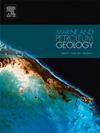The methane-sulfate transition interface in offshore sediments serves as a critical boundary for abrupt transitions in sedimentary environments
IF 3.7
2区 地球科学
Q1 GEOSCIENCES, MULTIDISCIPLINARY
引用次数: 0
Abstract
Methane is commonly observed in unconsolidated sediments prevalent coastal areas. It widely acknowledged within the scientific community that the methane-sulfate transition zone (SMTZ) forms due to the upward diffusion of methane and downward diffusion of sulfate within these sedimentary environments. However, this study presents a detailed analysis using a borehole sample from the continental shelf of the East China Sea as a representative case study, revealing distinct findings. The entire borehole was 60 m long and predominantly composed of clay with extremely fine sediment particles, conditions that are inherently unfavorable for diffusion. The SMTZ was identified at a depth of 9 m. Geochemical characteristics of the sediments showed significant differences above and below this interval. The carbon-to-nitrogen (C/N) ratios, the carbon isotopic compositions of total organic carbon (TOC), and nitrogen isotopic compositions of total nitrogen (TN), etc., all showed a peak at this specific depth. Additionally, elements such as thorium (Th), vanadium (V), cobalt (Co), and nickel (Ni), along with redox condition indicators such as the Ni/Co and Th/U ratios, demonstrated abrupt changes around the 8.5 m mark. The findings of this study suggest that the SMTZ functions as a transitional interface within the sedimentary environment, rather than merely representing the boundary where methane and sulfate converge. This insight is crucial for enhancing our comprehension of global carbon cycling in marine sediments, as prevailing estimates of methane release fluxes based on concentration gradient diffusion theory may lead to significant discrepancies between estimated and actual values.
求助全文
约1分钟内获得全文
求助全文
来源期刊

Marine and Petroleum Geology
地学-地球科学综合
CiteScore
8.80
自引率
14.30%
发文量
475
审稿时长
63 days
期刊介绍:
Marine and Petroleum Geology is the pre-eminent international forum for the exchange of multidisciplinary concepts, interpretations and techniques for all concerned with marine and petroleum geology in industry, government and academia. Rapid bimonthly publication allows early communications of papers or short communications to the geoscience community.
Marine and Petroleum Geology is essential reading for geologists, geophysicists and explorationists in industry, government and academia working in the following areas: marine geology; basin analysis and evaluation; organic geochemistry; reserve/resource estimation; seismic stratigraphy; thermal models of basic evolution; sedimentary geology; continental margins; geophysical interpretation; structural geology/tectonics; formation evaluation techniques; well logging.
 求助内容:
求助内容: 应助结果提醒方式:
应助结果提醒方式:


